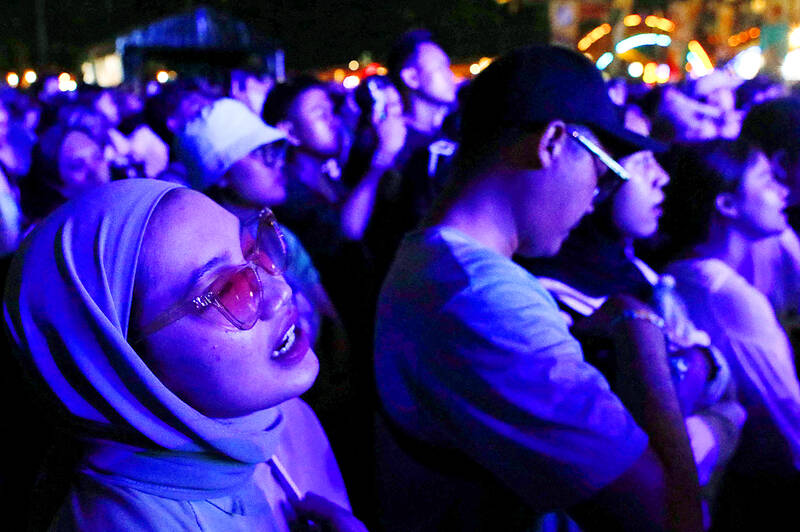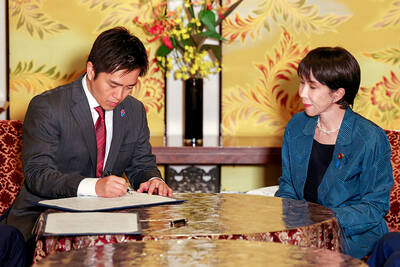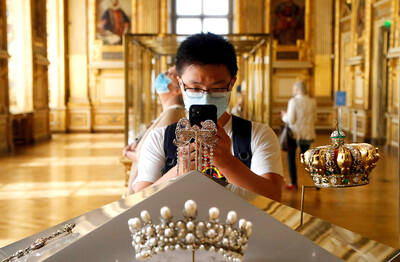At a packed festival in central Jakarta, hijab-clad sexagenarian singer Rien Djamain bursts into an upbeat track about nuclear destruction to a crowd of thousands, mostly young Indonesians.
Behind the lead woman of the all-female Nasida Ria band are her fellow musicians, dressed in silver and black sequined dresses, backing up her velvety vocals with bongos, violins, mandolins, bamboo flutes and tambourines.
“O cursed creator of the nuclear bomb, why do you invite the day of judgement?” she sang on the track Bom Nuklir.

Photo: Reuters
Young concertgoers swung from side-to-side during the macabre ditty, shouting “mother!” at their favorite band members.
Originally formed 47 years ago as a Koran recital group, the band numbers a dozen performers, fusing Arabic and traditional Indonesian dangdut music, which was once thought tacky and dated in cosmopolitan circles.
Their humorous Islamic pop tunes about serious themes, such as justice and human rights, have caught on with social media-obsessed young people looking for some levity in their playlists.
Riding the wave of Indonesia’s increasingly vibrant music scene, the band’s droll lyrics have gained them a certain notoriety. Their songs are laden with similes and metaphors, comparing womanizers to “seditious bats” or describing how “monkeys like to carry rifles, humans like to show nipples.”
Fathul Amin, 23, said he thinks the band is “more than just cool.”
“Why? Because all of the members are women who can play more than three musical instruments,” he said.
Screen grabs of Nasida Ria’s expressive words have been widely shared as memes, forging a connection between the band and the younger generation.
“That is how youths communicate nowadays, and that is OK. More importantly, it shows that our messages through the songs are well accepted,” Djamain said. “I am grateful that despite the mostly old members, Nasida Ria is still loved by the youths. That our music is still enjoyable to them.”
Music consumption in Indonesia is evolving, experts say, with listeners adding combinations of genres that include more traditional sounds — such as dangdut with Javanese lyrics or reggae-pop sung in eastern Indonesian dialects — to their Western favorites.
That growing trend has made Nasida Ria more relevant than ever, music journalist Shindu Alpito said.
“The younger generations tend to celebrate music with a sense of humor. They are attracted not only to the musical aesthetics but also musical comedy,” he said.
Dangdut music has been increasing in popularity, with acts playing at festivals across Indonesia, performing for young audiences alongside rock bands, in addition to gigs for their usual crowds in smaller villages.
“A lot of youths in ... Jakarta are re-embracing local music. Now, these types of music are what they call a guilty pleasure,” Alpito said. “Islamic songs are usually serious, with lyrics carefully quoting Islamic teachings. However, Nasida Ria have charmed broader society through a language style that is easy to understand and amusing.”
The group capitalized on the demand for entertainment while the world was stuck indoors and concert venues were closed during the COVID-19 pandemic.
Nasida Ria’s youngest member, 27-year-old Nazla Zain, attributes their success to modern technology allowing people from all backgrounds to be exposed to their music.
“We are keeping up with the trend by using YouTube and other music applications,” she said. “So now youths with mobile phones can listen to our songs. That might be a reason why they like us.”
They have seen their YouTube subscriber count surge sixfold since March 2020 to nearly 500,000. They also boast about 50,000 listeners every month on streaming platform Spotify, and have 38,000 followers on Instagram.
“They are so cool as they still perform at a not-so-young age,” said 32-year-old metal and punk fan Ricky Prasetyo. “No wonder many people call them the indie mothers.”

Indonesia was to sign an agreement to repatriate two British nationals, including a grandmother languishing on death row for drug-related crimes, an Indonesian government source said yesterday. “The practical arrangement will be signed today. The transfer will be done immediately after the technical side of the transfer is agreed,” the source said, identifying Lindsay Sandiford and 35-year-old Shahab Shahabadi as the people being transferred. Sandiford, a grandmother, was sentenced to death on the island of Bali in 2013 after she was convicted of trafficking drugs. Customs officers found cocaine worth an estimated US$2.14 million hidden in a false bottom in Sandiford’s suitcase when

CAUSE UNKNOWN: Weather and runway conditions were suitable for flight operations at the time of the accident, and no distress signal was sent, authorities said A cargo aircraft skidded off the runway into the sea at Hong Kong International Airport early yesterday, killing two ground crew in a patrol car, in one of the worst accidents in the airport’s 27-year history. The incident occurred at about 3:50am, when the plane is suspected to have lost control upon landing, veering off the runway and crashing through a fence, the Airport Authority Hong Kong said. The jet hit a security patrol car on the perimeter road outside the runway zone, which then fell into the water, it said in a statement. The four crew members on the plane, which

Japan’s ruling Liberal Democratic Party (LDP) and its junior partner yesterday signed a coalition deal, paving the way for Sanae Takaichi to become the nation’s first female prime minister. The 11th-hour agreement with the Japan Innovation Party (JIP) came just a day before the lower house was due to vote on Takaichi’s appointment as the fifth prime minister in as many years. If she wins, she will take office the same day. “I’m very much looking forward to working with you on efforts to make Japan’s economy stronger, and to reshape Japan as a country that can be responsible for future generations,”

SEVEN-MINUTE HEIST: The masked thieves stole nine pieces of 19th-century jewelry, including a crown, which they dropped and damaged as they made their escape The hunt was on yesterday for the band of thieves who stole eight priceless royal pieces of jewelry from the Louvre Museum in the heart of Paris in broad daylight. Officials said a team of 60 investigators was working on the theory that the raid was planned and executed by an organized crime group. The heist reignited a row over a lack of security in France’s museums, with French Minister of Justice yesterday admitting to security flaws in protecting the Louvre. “What is certain is that we have failed, since people were able to park a furniture hoist in the middle of